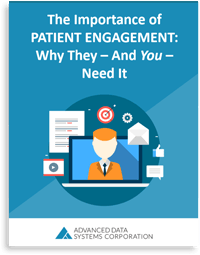Healthcare Blog
The latest in all things RCM, Electronic Health Records, Radiology Information Systems, Practice Management, Medical Billing, Value-Based Care, & Healthcare IT.

By:
Stephen O'Connor
September 14th, 2015
According to United States Census Bureau data, there are more than 691,000 thousand physicians and surgeons practicing medicine in the US. Many of these healthcare providers work in private practices and clinics, often with administrative support staff and other healthcare personnel.

By:
Stephen O'Connor
September 11th, 2015
Over the past two decades, revenue cycle solutions have evolved from a traditional back-office challenge to a major focus throughout the organization. Every individual in the medical practice from the C-suite to the exam room is expected to keep a critical eye on the revenue stream.

The Importance of Patient Engagement: Why They - And You - Need It
Learn why patient engagement is a necessity and how you can master it within your practice.

By:
Stephen O'Connor
September 9th, 2015
A 2012 survey published by Oracle revealed hospitals lose an average of 15%, roughly $72 million dollars, of additional revenue for each year because they fail to exploit collected information. Almost two-thirds, 63%, of polled respondents recognized the need to translate data into actionable insight, but felt overwhelmed by the volume of information.

By:
Stephen O'Connor
September 9th, 2015
Forty percent of healthcare management professionals surveyed by Oracle reported their current systems couldn’t meet specific industry requirements. RCM services that leverage financial, clinical, and other related data generate valuable opportunities to improve workflow patterns.

Medical Billing / RCM | Practice Management
By:
Stephen O'Connor
September 4th, 2015
Health rule challenges continue, even as October 1, 2015 looms. Individual insurance benefits fluctuate as employers scramble to control costs, making it increasingly difficult for hospitals and physicians to stay on top of diverse policy provisions and exclusions. Myriad new regulations and mandates for providers and employers also means more responsibility for paying for health care services falls into the hands of patients.

Electronic Health Records | Industry News
By:
Advanced Data Systems Corporation
September 3rd, 2015
The following excerpt is from an article found on U.S. News Health. It was written by Magaly Olivero. The days when doctors riffled through a folder bulging with papers to find crucial information about a patient's medical history are disappearing. Today, health care providers at many physician practices, hospitals and health systems across America rely on electronic medical records that give the medical team, patients and their family members easy access to the same critical data.

By:
Stephen O'Connor
August 31st, 2015
Successful medical practices must take advantage of the latest developments in software and computers if they want to position themselves as a leader in their service area. This means, for example, that they will reject old ways of doing things when presented with a more modern and efficient method for finishing tasks. A good example of this is practice management software. Organizations that managed to get by without this kind of software in the past, relying on paper based systems or a cobbled together collection of applications from unrelated developers will quickly see that practice management software will shorten the revenue cycle and keep the office humming along, running as efficiently as possible.

Medical Billing / RCM | Practice Management
By:
Stephen O'Connor
August 28th, 2015
You’ve experienced problems in the past with how you billed your patients, leading to missed payments as well as a much longer revenue cycle for those that do pay. Now you are growing more serious about finally using dedicated software that was built with your organization’s needs in mind. As you and your staff prepare to bring a new medical billing system into your practice, you will likely have some pressing questions that need answering before you can make your selection. Here are the answers to your top five medical billing system questions.

By:
Stephen O'Connor
August 27th, 2015
Technology has dramatically changed the way physicians practice medicine today. Connected devices do everything from helping patients manage diabetes and exercise schedules to enabling video conferencing with specialists around the globe to treat complicated cases. In many ways, it has improved both quality and continuity of care while empowering patients to take control of their personal health and wellness. However, simply plugging into the cloud isn’t enough. Optimizing cloud performance is only achievable with stellar software and compatible devices in the mix.

Medical Billing / RCM | Practice Management
By:
Stephen O'Connor
August 24th, 2015
Managing highly-specialized implementation, such as the shift to ICD-10, requires highly-skilled team members. Over the past few years, hospitals and health systems have invested hundreds of millions of dollars collectively to prepare for the complex implementation. And, while physicians have not faced the arduous challenges that vendors, payers and hospitals have experienced, they can benefit from the lessons learned. For example, outsourcing medical coding and billing services may be the key to managing a healthy revenue stream and improving your practice as a whole.